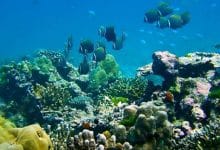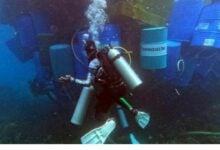3D-printed coral islands to rejuvenate Phuket’s degraded reefs

The coastal waters of Racha Yai Island, south of Phuket, are about to witness a groundbreaking ecological restoration project. The Department of Marine and Coastal Resources (DMCR) initiated a project to install 88 sets of 3D-printed coral larvae islands at Siam Bay, to restore the severely degraded coral reef in the area.
At the helm of this inaugural installation was Weeraphan Thongmak, the Director of the DMCR’s Marine Resources Restoration Division. The project is financially backed by Thai Union Group Public Company Limited, represented by Adam Brennan, their Group Director of Sustainable Development.
A significant contributor to the project is the Siam Cement Group (SCG) which has created the 3D-printed forms to be installed at the reef site. Sukthawat Pattawarakorn, Director of Natural Resources and Social Mission at SCG, was present on the occasion, representing the CPAC Green Solution initiative. CPAC functions under SCG Cement, a company founded by royal decree of King Rama VI in 1913, with its major shares owned by His Majesty King Vajiralongkorn.
Phuket’s diving community played a key role in the actual installation of the 3D-printed forms. Paitoon Panchaiyaphum, Director of the DMCR’s Conservation and Resource Management Department, elaborated on the challenging circumstances surrounding the reef site.
The reef area, covering about 50 rai, has seen a drastic deterioration due to various factors, including tourism, diving activities, and the natural bleaching of corals.
The surge in tourism activities has particularly disrupted the recovery of corals. Once a haven for staghorn corals and other fragile corals, the area has suffered irreparable damage, leaving behind fragments that over time decay and break down into small fragments. While these coral remains would naturally serve as a base for coral larvae to colonise and grow, the process takes numerous years, reported The Phuket News.
The situation is further aggravated by waves washing the larvae up or off the reef into deeper waters. The resulting sand, while aesthetically pleasing, is not suitable for coral larvae to land on. The thriving tourism activities, especially the daily scuba diving sessions, have added to the disruption, preventing the larvae from attaching and growing.
This necessitates the creation of shelters on the sea floor, suitable for coral larvae to attach to. Racha Island, being a tourist hotspot, presents its unique set of challenges for this reef restoration project. The DMCR has previously carried out successful reef restoration projects, employing various methods such as planting corals and placing bases in the area.
The Marine Resources Conservation Division, in collaboration with SCG CPAC Green Solution and the Faculty of Veterinary Medicine at Chulalongkorn University, has developed a base material for coral larvae to attach to, using 3D printing technology. The resulting concrete material is eco-friendly, durable, and aesthetically pleasing, mimicking the natural coral reef’s shape and texture.
Thai Union Group Public Company Limited has been sponsoring this project for three years. It is anticipated that corals will begin colonising the modules within a year of placement. The DMCR, with the help of volunteer divers, will continue to collect and attach living coral fragments to the base, thereby accelerating the coral settlement process.
The DMCR will also encourage dive shop operators in the area to train divers to grow coral. This initiative will be under the supervision of the relevant officials, ensuring a sustainable and responsible approach to reef restoration. This promising project marks a significant step towards preserving and rejuvenating Thailand’s precious marine ecosystems.
Latest Thailand News
Follow The Thaiger on Google News:


























